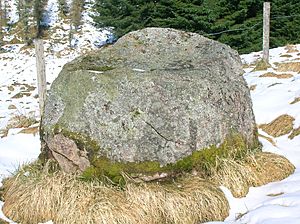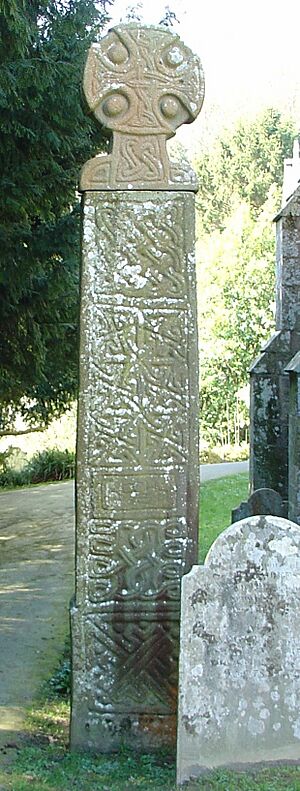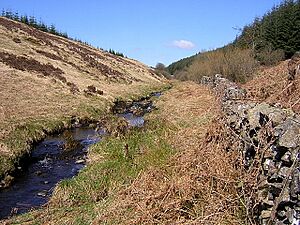Gowk stane facts for kids
A gowk stane is a special type of stone found in Scotland. The name means "cuckoo stone" or "fool's stone." These stones are often large standing stones or huge rocks left behind by glaciers, called glacial erratics. You can usually find them in important places in the landscape.
Contents
What Does 'Gowk' Mean?
In Scots, the word "gowk" means a common cuckoo bird. It can also mean a silly person or a fool. The word comes from an old language called Old Norse, where 'gaukr' meant cuckoo. The English name for the cuckoo bird also comes from the sound it makes!
Long ago, people in Scotland had a special day called Gowk's Day. This was like April Fools' Day, but it was on April 13th. This was usually when the cuckoo birds started calling. Children would play harmless tricks, like sending friends on a "gowk hunt," which meant a pointless errand.
Fun Facts About Cuckoos
Many old stories, especially from Celtic mythology, talk about cuckoos. These stories help us understand why some stones were named "gowk."
- Some people believed that the cuckoo's call could connect to another world.
- It was thought that the first cuckoo of spring would bring a "gowk storm." This was a strong spring storm!
- Cuckoos were also believed to have special powers. They could supposedly tell how long a person would live. They might even predict how many children someone would have or when they would get married.
- In the Outer Hebrides, hearing a cuckoo when you were hungry was bad luck. But if you had just eaten, it was good luck!
Gowk Stones and Spring
The name "gowk" for these stones often links them to springtime. Many old stories about standing stones connect them to the first cuckoo's call of the season.
For example, in a churchyard in Nevern, Wales, there is an old stone cross. Villagers would wait for their "harbinger of spring." On April 7th, St Brynach's feast day, the first cuckoo of the year would arrive. It would land on the cross and sing, announcing that spring had finally come.
On the Isle of Lewis, people believed something similar. When the sun rose on midsummer morning, a "shining one" would walk along the stone path at Callanish. The cuckoo's call would announce his arrival. In Northern Ireland, the cuckoo traditionally makes its first spring call from the gowk stone at Lisdivin.
Other Uses for Gowk Stones
Besides their connection to cuckoos, gowk stones often had other important jobs.
- They could be used as boundary markers. This means they showed where one area ended and another began.
- They were also used as meeting places. This was especially helpful in areas that looked very similar.
- The gowk stone at Whitelee might have even been used as a type of outdoor pulpit. Ministers would preach there during Covenanting times.
Where to Find Gowk Stones
Many gowk stones are found across Scotland and Northern Ireland. Here are a few examples:
- Gowk Stane, Laigh Overmuir, Darvel, East Ayrshire: This is a large rock left by a glacier in a very noticeable spot.
- Gowk Stone, Lisdivin, County Tyrone, Northern Ireland: This is the stone where the cuckoo traditionally makes its first call in spring.
- Gowk Stone, Auchencorth, Penicuik, Lothians: This stone sits on a hill overlooking the River North Esk. It's also called the Auchencorth Stone.
- Gowk Stone, Great Cumbrae Island: This is a natural standing stone. Another one nearby is called the Gouklan Stone.
- Gowk Stane, Oyne, Inverurie: This standing stone is about 2 meters tall and stands on a hilltop.
Some similar stones are also found in England and Cornwall:
- Cuckoo Stone, Durrington, Wiltshire: This stone is now lying down.
- Cuckoo Stones, Haworth, Yorkshire: There are two cuckoo stones here.
- Cuckoo Rock, Penzance, Cornwall: This standing stone is now known as the Carfury Stone.
Images for kids








